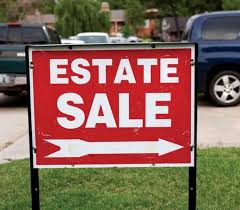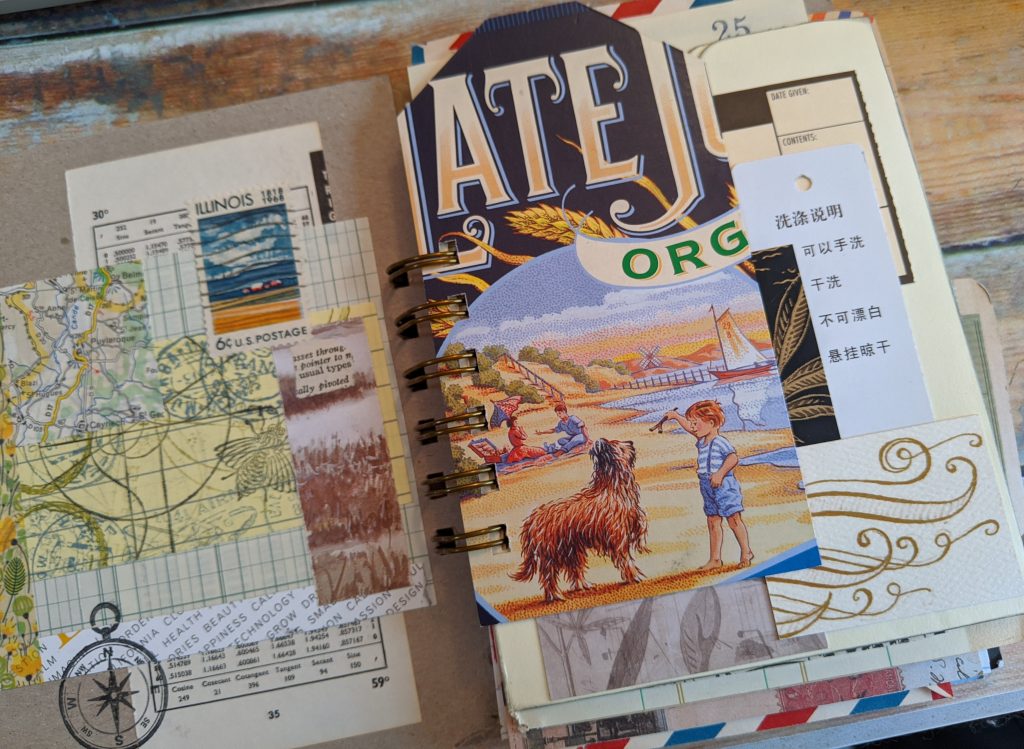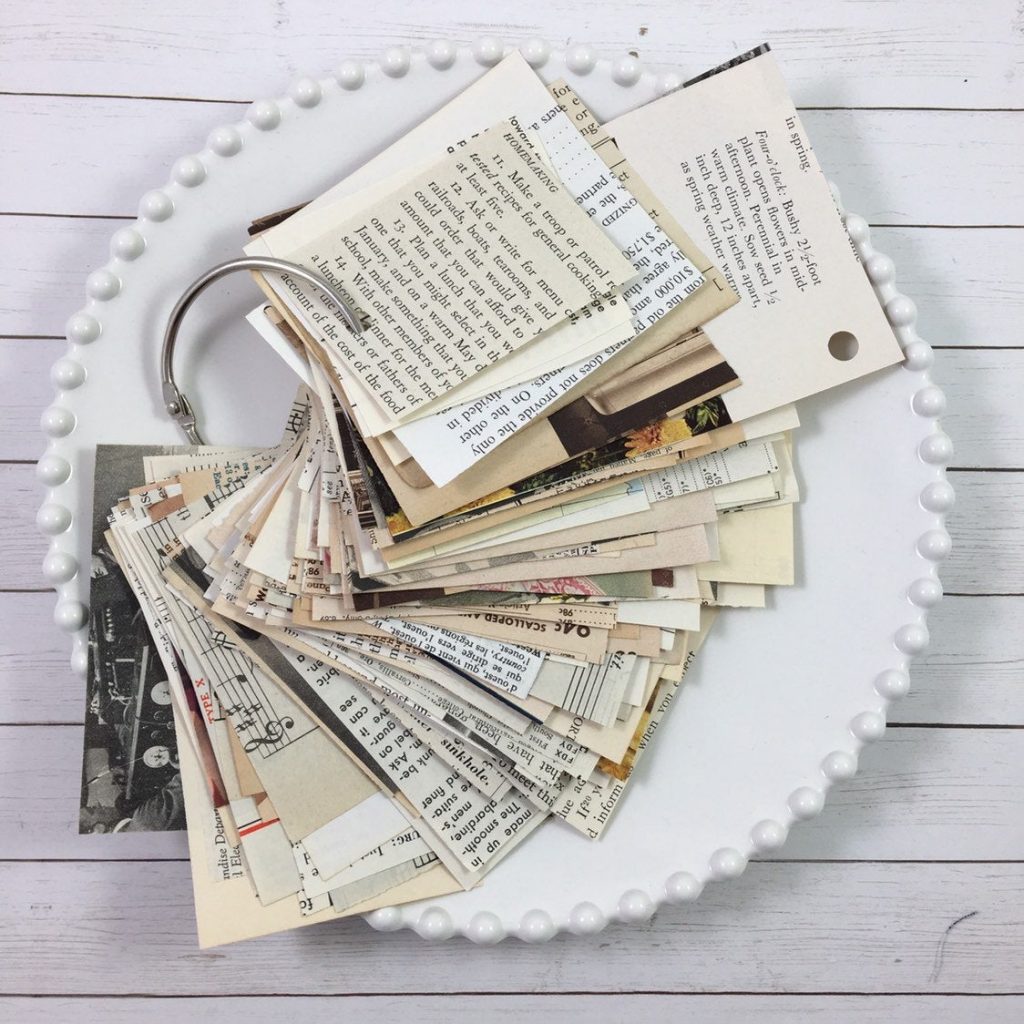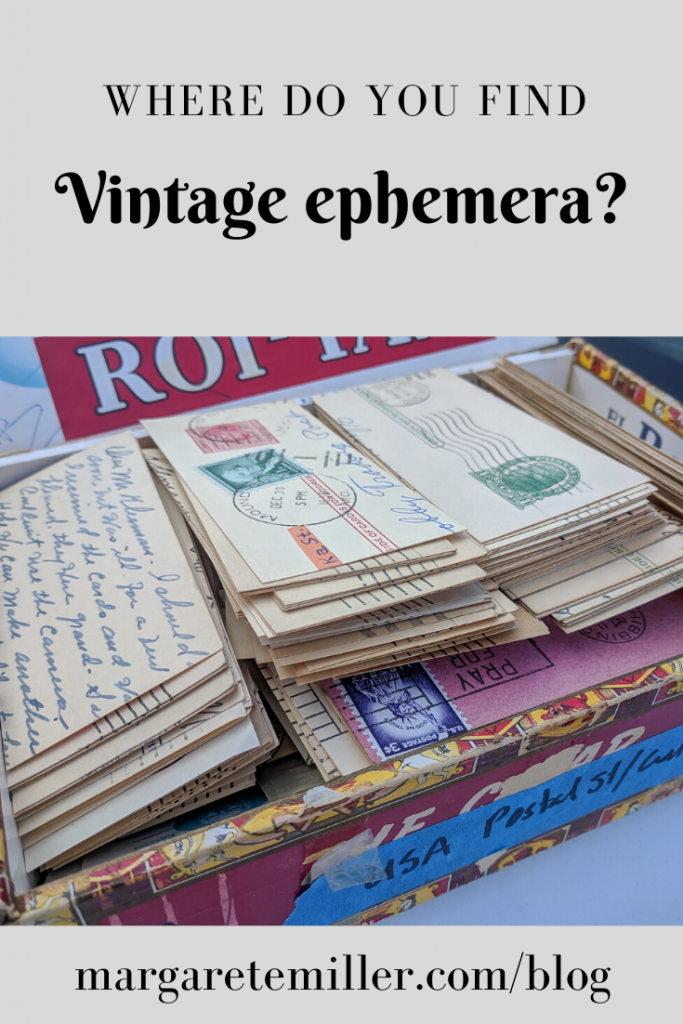Where do you find vintage ephemera?
When you are beginning in collage art, or when you start to get familiar with it, you often develop an idea of the kinds of papers you’d like to work with. For those of us who like the vintage style, it can be hard to find what you are looking for. Where do you find vintage ephemera? Bits of interesting paper can be found everywhere. Sources are in the area around where you live, as well as online.
Second-hand materials
Original vintage images and illustrations are found in old things, and the best place to find old things are (in no particular order), antique malls, second hand stores like the Salvation Army or Goodwill, estate sales and garage sales, at flea markets, or at library used book sales.
I love looking for antique malls when I travel anywhere. Yes, things can be pricey in an antique mall, but 1) I’m selective with the vintage ephemera paper items that I buy, and 2) shop owners are usually trying to earn an income from what they sell. Sometimes I think of my purchase as payment toward their rent so they can say in business and continue to scout for more ephemera to make available for sale. It’s all a cycle, and one I don’t mind contributing to once in a while. My closest antique mall in San Jose is a pretty good one, with plenty of postcards, old ledgers, and photos, and I’d be disappointed if they had to close down due to lack of sales.
Local charity shops are hit or miss. The only way you can discover this is to make visits over time, if it’s convenient. These shops tend to carry old books, however, and it’s often possible to find Reader’s Digest books, books in foreign languages, outdated electronics books, science and nature books, etc. Doing a quick flip through makes it easy to determine if you can use pages for backgrounds or if you could see yourself fussy cutting out images to use in making collages.

Have you ever been driving down a road and have seen a printed sign for an estate sale? You might want to think about stopping by, just to find out if the business who is running the sale has an email list you can get on. That’s what I did, and the great thing is that they send out an announcement days in advance with the next upcoming sale, and they usually include a description and photos. That way, if an estate sale will be coming up in my neighborhood or not too far away, I can decide if it’s worth my time or not. Most of the time I skip. I go, however, if I see photos of a home office or library that look well stocked. I’ve found some good materials this way.
Library book sales are wonderful. I always have to be careful not to buy more than I need. Often there are so many old, beautiful books at my local monthly used book sale, the temptation is there for me to buy something even if 1) there is no project in mind for using the book, 2) there is no time to develop a project I could use the book for, and 3) I really, really, really don’t need to store another book at home. It’s so hard to be strict with yourself when faced with beautiful old books priced cheaply.
The environment around you
What about papers that you find around you in your day-to-day living? Where do you find vintage sources? I see potential in paper all around me. In the grocery store I see interesting food packaging. In the US, Trader Joe’s grocery chain uses vintage-style images in their monthly flyer. My mailbox is a source of all kinds of images and text I find in brochures, catalogs, and advertisements. It takes just the smallest amount of practice, but a “paper-fodder eye” is something that can be switched on pretty easily. A warning, though; once your eye has been switched on, you may wish you could turn it off. All of a sudden you may be in danger of paper hoarding and stash overload. Watch for symptoms, for example, of people giving you funny looks for digging in and taking things out of the post office recycle bin. ;-)

Buying vintage papers online
In my experience, the two best places to buy vintage papers online are on Ebay, and Etsy. Ebay has a huge variety of listings so it’s possible to get very good results searching for something specific, like “vintage Victorian calling cards”, or more broad, such as “old letters”. Ebay is also a good source for used postage stamps.
If you are not familiar with Etsy, they are an online seller of hand-made goods and craft supplies. I’ve had good experiences with buying sets of paper scraps and collections of vintage labels. With searching on Etsy, you’ll have more success if you have a more specific idea what you are looking for. I don’t enjoy fussy cutting or tea dying paper, so would rather buy from someone who is selling those items, plus it saves me a lot of time.

My last bit of advice for shopping online is to set yourself a budget before looking, and then stick to it. It’s so easy to fall into the rabbit hole of looking for beautiful vintage papers, and then talk yourself into considering, for example 200 vintage trade cards for $60.
“OMG, that’s a good price! That’s 30 cents a piece!! I could find a way to use them eventually, right?”
I’m a little afraid that I have the potential to become a hoarder, so I’m good at resisting… most of the time.
The internet and a printer
Obviously, the sky's the limit for looking for images online to collage with. The only thing holding you back might be the use of a good printer. If you don’t have a printer at home, local print shops can print for you. You can do this by uploading your images onto a memory stick, or looking up the store online to see if they have a way for you to upload your images online for store pick up.
For searching, Pinterest is a good place to start for general ideas, or if you’re not sure what you are looking for. Pinterest has become a search engine for images. The quality of many images may make them unsuitable for printing (low resolution), and often, you don’t know where the original image came from. Unfortunately, there are a lot of vintage pinned images that are copyright protected. It can be kind of a sticky situation where you’d like to use an image but don’t feel right about printing and using someone else’s digital property without their permission.
If you are concerned about copyright issues of printing images that are not yours, you can look for copyright-free images through online libraries. For example, the British Library released over a million images on Flikr: There are many of these kinds of free online resources. Here are just a few:
Biodiversity Heritage Library: https://www.biodiversitylibrary.org/
British Library: https://www.flickr.com/photos/britishlibrary.
Old Book Illustrations: https://www.oldbookillustrations.com/
Smithsonian Libraries: https://library.si.edu/books-online
Library of Congress: https://www.loc.gov/free-to-use/
New York Public Library: https://digitalcollections.nypl.org/
Non-library sites:
Raw Pixel: https://www.rawpixel.com/category/53/public-domain
Graphics Fairy: https://thegraphicsfairy.com/category/printables/
Reusable art: http://www.reusableart.com/
If you need a little assistance with how to search for topics, here’s an article on web search that provides some advice.
Digital download kits are another good way to go. Etsy hosts many artists who sell digital collections that may be very specific to your vintage ephemera interests. To find them, begin with typing in “vintage digital download” into the search bar and see what comes up. I’ve purchased, downloaded, and printed several collections from Ephemera’s Vintage Garden, for example, and love to use those when creating junk journals. I, too, have created a few digital downloads from some of the ephemera I’ve accumulated over the years. :-)
What else have I missed? Is there a resource you like using? Let me know in the comments.
Related articles:



